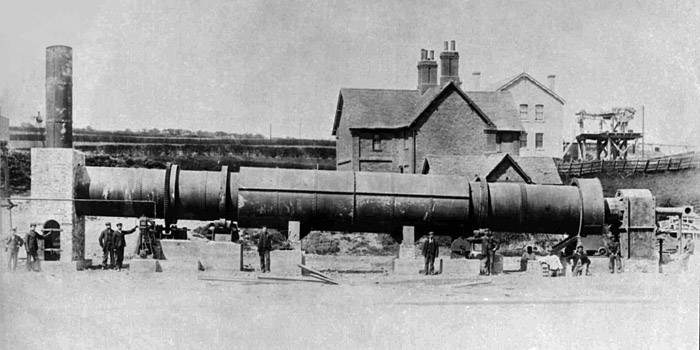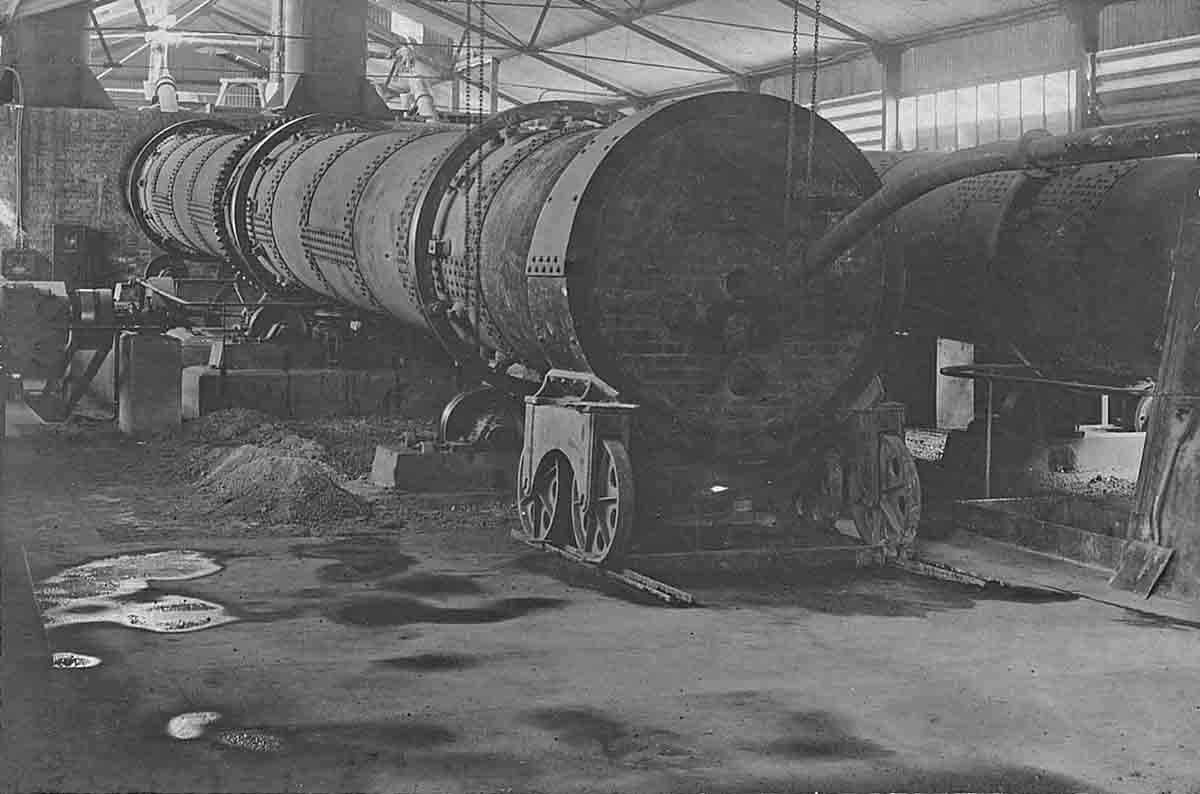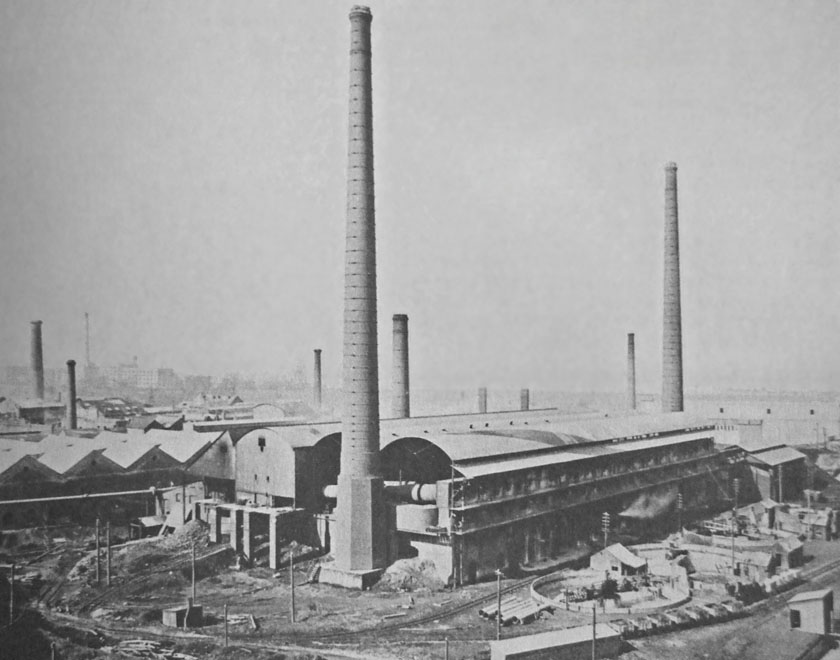
Picture: a much-reproduced image of Martin Earles Kiln A1 in 1901, taken from the original plate. This has often been claimed to be the first successful British rotary kiln.
As noted in the account of early rotary kilns, the identity of the earliest rotary kiln to operate successfully in Britain is disputed. For political reasons, many claims to this distinction were made. It can safely be said that the identity of this kiln cannot currently be firmly established, although probably the Martin Earles kiln was the first to operate, albeit for a short experimental run. However, it is amusing to assemble in one place a number of statements that have been made.
Thames 1887: An article written by R. J. Friswell ("On Ransomes' Improvements in the Manufacture of Portland Cement", The Engineer, 4 March 1887, pp 177-8) concerning the Ransome kiln at Grays is mentioned by A. J. Francis (p 234). He says:
No defects are mentioned and one must assume that it was written before the trials had begun. The article states that a works with two such kilns could produce 336 tons of cement per week.
Friswell was a chemist and was evidently acting as a technical advisor and patent agent to Ransome. Although the article is highly misleading as a historical source, I have transcribed it with copious notes here. A careful reading indicates that it is a rather verbose rendering of Ransome's very conjectural patent, presented in such a way as to imply that the process was actually happening in the real world. He does mention "the occasion of my inspection of Mr. Ramsome's (sic) experimental furnace at Grays, Essex" in which he describes it making a sandy product, at an implied energy consumption below 3 MJ/kg! Although all the Ransome kilns "proved to be expensive failures", the article was sufficient to persuade the Navarro brothers to try the kiln - successfully - in Pennsylvania.
Swanscombe 1901: A. J. Francis (pp 256-7) says:
Hurry and Seaman obtained English patents for their process and these were later sold to a firm of British contractors, Messrs Samuelson & Fawcus, who established a limited company, Hurry & Seaman’s Patents Ltd, to handle them. By an agreement with that company dated 11 August 1899, J. B. White & Brothers contracted to use the patents for the manufacture of cement not exceeding 425,000 tons per year at a fixed royalty per ton of cement made by the rotary process. The agreement also provided for an initial lump sum advance payment of £20,000. An order for 14 rotary kilns (which was later increased to 16) and associated plant was placed with a German engineering firm and erection of the first of these kilns began in the winter of 1900/1901, the total expenditure being in the region of £120,000. The kilns were expected to produce up to 3,000 tons of cement per week and their installation was followed by the erection of three rotary kilns for the Sussex Portland Cement Co Ltd made by F. L. Smidth & Co of Copenhagen and which were 18 m long and 1.8 m in diameter. Within a few years most of the cement works of any size throughout the country had installed one or more such kilns.
The implication is that the first Swanscombe kiln started up in early 1901.
Martin Earles 1900: In a footnote to the above, A. J. Francis says:
It seems that Martin, Earle & Co Ltd had, during 1900, themselves constructed their own experimental rotary kiln which was tested and modified over a two year period before further kilns were installed. (The Blue Circle, Oct 1954, 5-6.)
This is the kiln shown above. It would appear that this started before the end of 1900, although it may well not have been seriously operational before 1902. Statements from Martin Earles are always unreliable, but a 1900 start-up is corroborated by J. F. Plaister. The subsequent kilns began operation in 1903. See also the article on Martin Earles.
Shoreham 1901: In the Francis quote above, three F. L. Smidth kilns for Sussex Portland Cement Co Ltd are mentioned. He is quoting without reference from the Discussion of the January 1901 meeting of the Institution of Civil Engineers. The FLS rotary kiln order book shows the first and second ordered 1897 (for Aalborg) followed by Numbers 3, 4 and 5 ordered in 1899 for "Shoreham". The next British kiln on the list is Number 52 for "Dunstable" (i.e. Sundon) in 1905. The "Shoreham" kilns are Shoreham A1 and A2 and Newhaven A1. The latter is not mentioned in the 1902 newspaper article, so its installation must have been delayed. However, Redgrave's 1905 edition gives clinker analyses dated 1901 for both the Shoreham and Martin Earles kilns. FLS suggest the Shoreham kilns were commissioned in 1900, but this is contradicted by a statement by J. F. Plaister, Manager of Shoreham (see below).
The glass negative of the well-known picture of the Shoreham kilns (below), which FLS have used to illustrate "the first British rotary kilns", has "1899" scratched into the emulsion in the corner. This was probably done long after the picture was taken: from the details of accompanying plates, it can be assumed that it was taken in 1902.
 Shoreham kilns 1 & 2: picture courtesy of Chris Down. These were probably the first rotary kilns to operate in Britain, after the one at Martin Earles.
Shoreham kilns 1 & 2: picture courtesy of Chris Down. These were probably the first rotary kilns to operate in Britain, after the one at Martin Earles.
A C Davis, in Portland Cement: 1st Ed (Stone Trades Journal, 1904) on page 39 shows the Martin Earles picture, with the caption “First Rotary Cement Kiln to be successfully Operated in England”. On page 41, an installation picture of the Shoreham kilns is shown, with the caption “Interior of Rotary Kiln Plant in England”. The picture probably dates from 1901. He was at this time an independent manufacturer, currently installing rotary kilns, and gives examples of other independents. In A Hundred Years of Portland Cement (Concrete Publications Ltd, 1924) on page 166, he says:
The practical development of the rotary kiln in Great Britain dates from the year 1900 when the recently-formed company The Associated Portland Cement Manufacturers purchased certain rights from Messrs. Hurry and Seaman and proceeded to build a number of rotary kilns on the Thames.
By this time, Davis was MD of APCM (Blue Circle).
Cook (p 25) quotes the latter, and goes on to say:
Other competitive cement manufacturers outside this Company also obtained information from the United States without the purchase of any rights and the year 1900 saw one or two other rotary kilns in course of construction at various places in the country.
Wouldham 1901: A. J. Francis (p 259) in discussing the uprating (with the help of Whites) of Wouldham, says:
An agreement was reached with Hurry & Seaman's Patents Ltd that one sixth of the annual quota of rotary cement allocated to J. B. White & Brothers Ltd could be made at the Lion Works. Six rotary kilns, 60ft long, together with additional chamber kilns were placed on order and were installed in 1901.
This implies that the Wouldham kilns were ordered as a variation of the original Swanscombe arrangement, and, at the earliest, were installed concurrently with the Swanscombe kilns. The likelihood is that the first Wouldham kiln started shortly after the first Swanscombe kiln.
Blezard (p 12) says:
The first rotary kilns to be erected in the UK were a battery of six small kilns at Thurrock in Essex (1900) . . . .
This reference to Wouldham is repeated by many others, although these kilns undoubtedly did not start until mid-1901. This account is repeated in Castle Group plant histories, along with the curious assertion that the plant in question belonged to Tunnel. This folk memory is perhaps convoluted with a claim by Stokes that six kilns were being installed at a plant "near Grays" (presumably Gibbs) following the "success" of the Gibbs Ransome kiln, and an idea (repeated by Jackson, p 280) that Gibbs was acquired by Tunnel. The Gibbs kiln installation was abandoned, if it ever started. Both Gibbs and Wouldham were part of Blue Circle.
Bevans 1903: A relatively authoritative source (C. Percy Taylor, "Fifty Years of Mechanisation in the Cement Industry" in Cement and Cement Manufacture, XX, 1947, pp 59-60) discusses Bevans:
When the Associated Company was formed in 1900 it had in hand the completion of sixteen rotary kilns at Swanscombe, two miles from Northfleet. This was the first installation of modern rotary kilns in England, and many difficult problems had to be solved before its success was assured. As soon as this was completed it was natural that rotary kilns should be installed at Bevans works, and eight were authorised in June, 1903. These, originally 70 ft. long, were later lengthened to 130 ft., and four kilns of this length were added between 1906 and 1913.
The Bevans project was part of the original APCM rotary manufacturing license, and evidently construction started as soon as the sixteen kilns at Swanscombe and the six at Wouldham were complete, the work being staggered presumably in order to maintain continuity of supply from the two largest British cement plants.
Billingham 1904: V. Turley, in his Illustrated History of Casebourne’s Cement Plant 1862-1972, (published 1980 - Teesside Archives U/CB/9) on page 5 described the rotary kilns at Billingham thus:
The plant had 4 rotary kilns, each being 100 ft long and 6½ ft in diameter. These were the first rotary cement kilns to be operated in England. Each had a daily output of 48 tons. (his underlining)
These kilns, he says, lit up on 10/08/1904. My database shows 47 kilns already operational on this date. The statement exemplifies the difficulties encountered in writing a history of this subject, when only parochial "local knowledge" is available. It would be nice to think that at least the light-up date is correct, in which case it's the only firm date in the whole saga.
Sundon 1905: Jackson in his article on Sundon (p 260) says:
The first wet-process rotary kiln arrived in 1900 . . . . . In 1905 an Edgar Allen wet-process kiln (No 2) was installed and this was another kiln which gave over 70 years service. . . . (it shut down in 1976.)
This also appears in the card index on page 299. On file (and often quoted) at Sundon was a manuscript stating that these kilns started in 1898 and 1902 respectively. The actual start-up dates for the two kilns were 1905 and 1909 respectively, and Kiln 2 shut down in its 68th year. No kiln ever achieved 70 years service. It seems that it was the practice at Sundon to move dates back along the time-line. The plant began in 1898, and installed Schneider kilns in 1900. It then installed kilns 1 and 2 in 1905 and 1909. The kiln installation dates were later "re-assigned", and some success was achieved in getting these dates accepted, throughout the company. Was this a deliberate lie? Or a naive chauvinism? Or just incompetence combined with a lack of respect for historical fact? P M Stewart was company managing director from the 1920s, and was Sundon plant manager when Kilns 1 & 2 were installed. 1920s production director A C Davis, as a member of the Forder/Keeble/Stewart clique, knew exactly what was going on, and was probably involved in the kilns' procurement. And yet the Blue Circle kiln schedule gives the date 1905 for kiln 2. The F L Smidth plant list gives 1905 as the order date for Kiln 1. I know which one I believe.
"Cement expert" A. B. Cockland, who worked at Sundon, and afterwards at Martin Earles, is mentioned in an article in The Engineer (120, July 23, 1915, p 82):
It was he who, when at Messrs. Forder's (i.e. Sundon), brought about the introduction of the first kiln of this type (i.e. rotary) to be put to work in this country subsequent to the original Ransome experiments.
He was seconded there in 1905.
The report of the Alkali Inspector for 1900 stated that in District 7 - the Eastern and South-eastern Counties, including Essex, Kent and Sussex - "five rotary kilns of more than one pattern" were being erected at five works in various parts of the district during 1900, but only one had actually been at work, and that for only a short period. This implies only one kiln per plant. The Alkali Inspector's intelligence was not altogether comprehensive.
There are, in short, lies, damned lies and kiln installation dates.

Picture: the block of sixteen Swanscombe kilns in 1908. These have often been claimed to be the first successful British rotary kilns.
Postscript 2021: When the above was written, I was aware of the frequently-quoted paper "The Rotatory Process of Cement Manufacture" that was presented at the 26/2/1901 meeting of the Institute of Civil Engineers by William Harry Stanger and Bertram Blount. The paper was based on a visit made by Blount to plants in the USA in 1898. There is no information on subsequent developments in Britain, except for the statement that:
extensive works are now being erected in England to handle wet raw materials.
This is a clear reference to Swanscombe, for which Blount was a consultant. However, I was unaware of the lengthy discussion of the paper that took place at the meeting. The minutes of this, it turns out, are considerably more illuminating about the situation at the start of 1901, containing contributions from a number significant leaders of the industry at the time, many of whom had made subsequent visits to the USA and had begun kiln projects in Britain.
F. A. White, chairman of APCM, mentioned that White's had already begun the process of obtaining the Hurry and Seaman patents before the formation of APCM, and that:
at the present time the Associated Cement Manufacturers had, at the largest works they had taken over, a plant, fast approaching completion, which was equivalent to the one unit referred to in the Paper, capable of an output of some 3,000 tons per week.
Again, this is Swanscombe, which clearly at the date of the meeting had yet to start up.
Both William Gilbert and William Lee Henry Roberts (Lee's) pronounced that Schneider kilns were preferable.
J. F. Plaister (Shoreham) said that rotary kilns had "occupied his attention for several years past", and he believed:
he had been the first English manufacturer to place an order for an American rotatory kiln in this country, although one manufacturer had been ahead of him in getting one started.
This seems a fairly clear admission that another plant (presumably Martin Earles, which he knew) had started up before Shoreham.